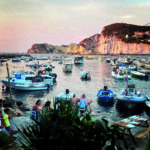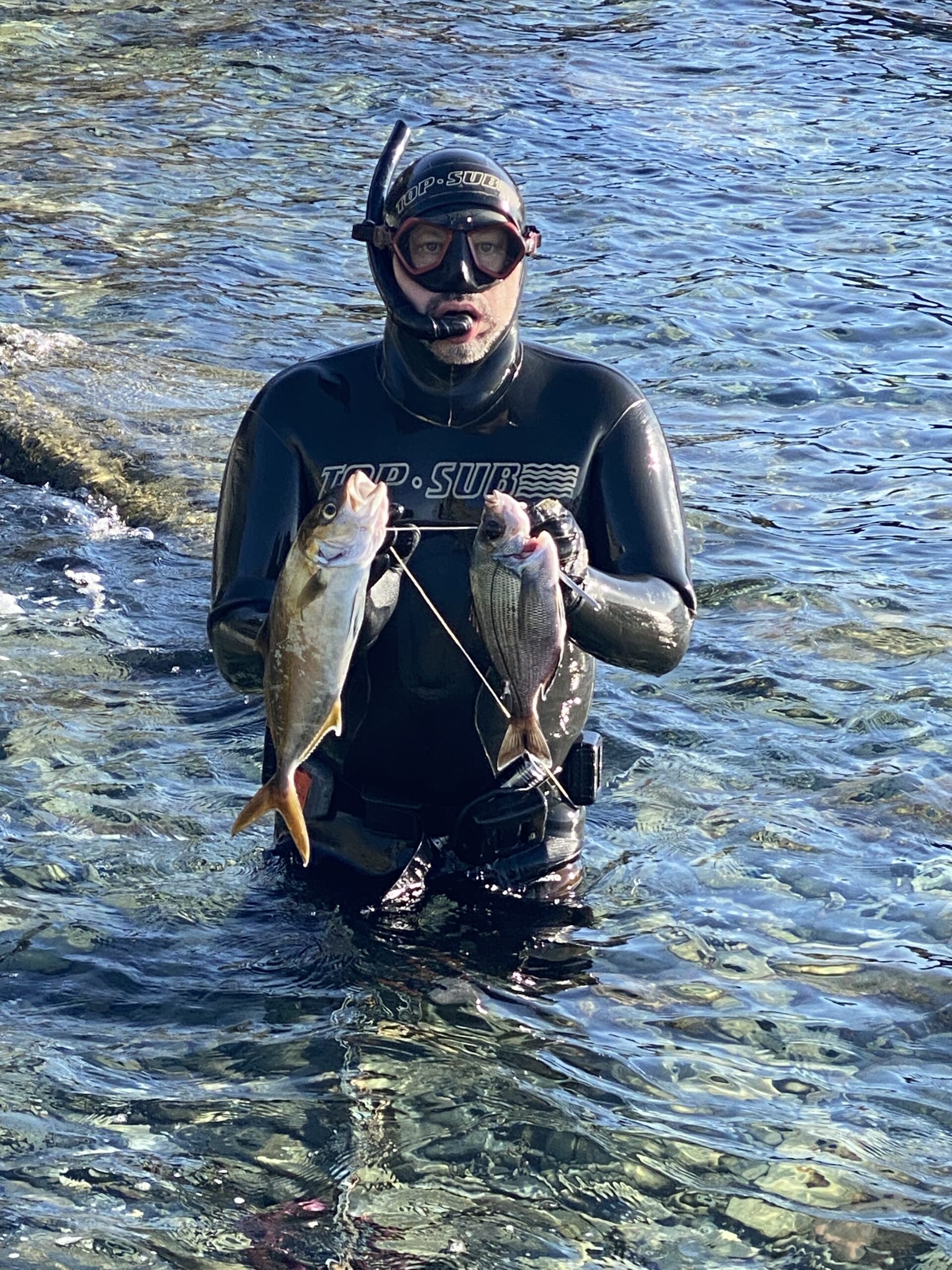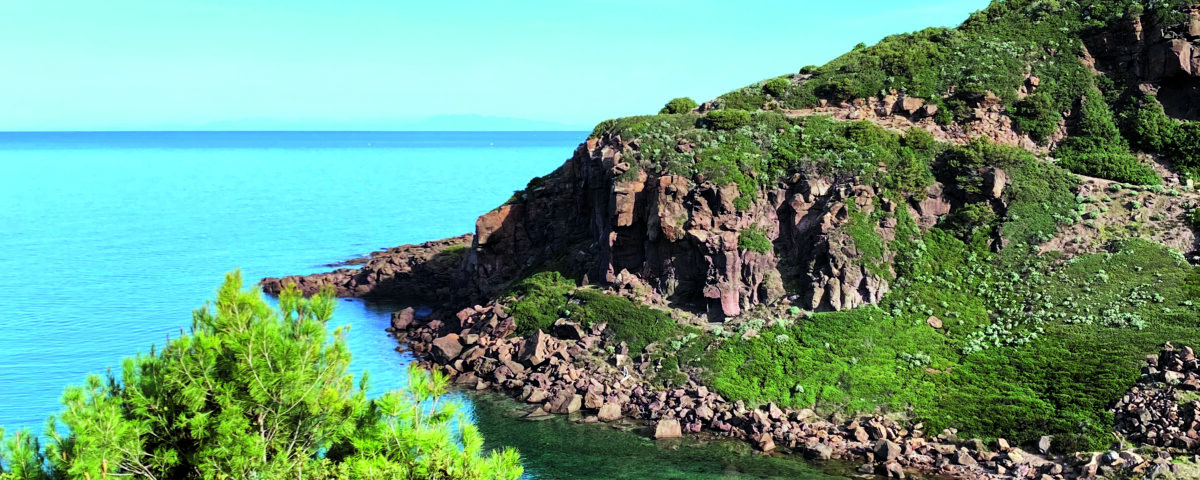Stintino in Winter

Ponza, the Crystal Island
11 September 2023
In Scotland, among seals and haddocks!
11 September 2023A holiday around New Year's was the perfect opportunity for some dives between Baia Ostina and Coscia di Donna, which usually teem with sea bass during this period. However, the unusually warm water had delayed their arrival. Nonetheless, there were no shortages of bream, sea urchins, mullets, and saddled bream.
by Gherardo Zei
Massimo Repetto, with his desire to travel and discover new places in Italy and abroad, has become a trailblazer for the vacation plans of many of our readers who, like most enthusiasts, are eager to have excellent experiences without going to extremes. We're talking about carefree days spent with friends and family, and enjoying some freshly caught fish.
This time, Massimo set off with only his wife to spend a few days around the last New Year's Eve with a relative who has a house in Platamona, Sardinia.
"My idea," Repetto tells us, "was also to try out the new 8-millimeter split-cell Yamamoto wetsuit, specially prepared for winter by Top Sub. I wanted to dive between Castelsardo, Stintino, and nearby areas, staying in shallow waters in search of sea bass. But in this strange year, Sardinia welcomed us with almost summer-like weather. During those days, the temperature was constantly around twenty degrees Celsius outside and about sixteen or seventeen degrees in the water. Therefore, I only used the 8mm wetsuit on the first day and then switched to the 6.5mm one.
"I was expecting around 14 degrees, although, certainly, the winter water in Sardinia remains less cold than in my Liguria, where it can drop below 12 degrees in winter. Then there's the Adriatic, which deserves a separate discussion because the winter water temperatures there in shallow seas are even lower. In any case, when I returned to Sardinia on that vacation, I didn't catch any sea bass, but I still spent beautiful days with some interesting catches and getting to know places and seabeds that deserve to be explored."
Baia Ostina
"On the first day, I was at Cala Ostina, east of Castelsardo, in a cove within the Gulf of Asinara. It's a popular bay because it's protected by two high promontories that shelter it from the force of the sea. In short, a splendid place with a clear beach and magnificent smooth pebbles. All around, the classic Sardinian Mediterranean scrub with its colors and scents.
"Some curious facts about the origin of the name of this locality are fun. In fact, there are those who believe that 'Ostina' is an abbreviation of 'Augustina,' as there were some settlements dating back to the time of Emperor Augustus in the area. In fact, even today, several archaeological remains can be appreciated. But there is another school of thought that believes the name 'Ostina' comes from the presence of a particular variety of small lobster.
"It's an easy place to reach because, just after the town of Castelsardo, you follow the road towards the sea and arrive at a parking lot that allows you to stop practically by the sea. You change with the usual containers of hot and soapy water and then enter a calm and sheltered spot. Swimming north, towards Isola Rossa, the seabed is ideal for staying in very shallow water in search of sea bass. You are indeed faced with a large shallow area that ranges from 4 to 10 meters, very similar to what you can find throughout the stretch between Castelsardo and Isola Rossa. We're talking about a seagrass meadow with rocks scattered at intervals and little white sand. Unfortunately, as I mentioned before, the sea temperature was too high for sea bass. There was plenty of food: small mullets and some mullets, but no sea bass. Therefore, even though I had equipped myself with a generous belt for the shallow waters, on the way back, I swam further out, at about 10 meters, with forays down to 15 meters, and saw a nice grouper and small croakers. I couldn't catch the grouper because it got stuck in a dark spot where I could see the sediment moving but couldn't see the fish. I could have caught it with a flashlight, but spearfishing with a light is prohibited in Sardinia. And I didn't have a boat that would allow me to remove the belt and go deeper, between 16 and 18 meters, to search for fish in caves, where I would have certainly found them. So, in the end, I settled and caught only a nice bream and an octopus, encountered near the exit point.

"A curious note was struck by a wild boar hunting expedition that was happening nearby. So, my wife, who had come to enjoy a beautiful sunny day in nature, found herself surrounded by these hunters. A funny situation to the point that, when entering the water, I told her to wear the 'orange vest' that was in the car and to stay close to the vehicle...
Coscia di Donna "For two days (one with rough seas and one with calm seas), I went to Coscia di Donna, a famous location in the 'mare di fuori' of Stintino. Among the beaches in the area, it's one of the wildest and least frequented by bathers due to its small size. However, it's stunning and worth a visit, also because it's easy to reach from Stintino: after the last stretch of dirt road, there's a clearing used as a parking lot from where various paths branch off towards the coves. According to some, the name Coscia di Donna derives from the shape of a wreck in the area. Others, who claim that the wreck is actually farther away, believe that the name originated in the 1950s and comes from the use of two-piece swimsuits by continental tourists.
"On the day with rough seas, I started from the parking lot, where there's the bay with the pebble beach. From there, you can go left or right. Given the sea conditions, I chose to go left, towards the inland, as it seemed like the safer area. The route was all rocky, with two or three peaks farther out and, in the end, an imposing point. The seabed dropped almost immediately between 10 and 16 meters, and there were plenty of waves. Equipped with generous weights, I had the idea of diving to the base of the rock and trying to ambush some fish by ascending from below to the breaking point. I thought I would catch the fish that were feeding in the foam of the waves and still hoped to catch a nice sea bass.
"I made many ascending ambushes and saw many medium-small mullets (around three to four hundred grams), but I didn't shoot, and I also spared a too-small saddled bream. In the end, I swam further out, and luckily, at about 15 meters deep, I spotted a group of beautiful saddled bream. I descended and caught one using the classic free-fall technique. I didn't find any other fish in the foam except for two terrified mullets. Maybe there was a giant barracuda around scaring them, and I didn't see it? This thought brings back memories of many years ago when I was a guest of the late Bruno De Silvestri, and he took me to Pula. Being a great champion, Bruno had a big catch, while I didn't catch much. On the way back, at a certain point, he stopped the boat and said, 'Go try two spots around that protruding rock, pointing the spear towards the coast. You'll find the biggest barracudas in Sardinia.'
"I thought he was joking, but I went anyway. As soon as I stopped to observe, a hundred large barracudas swarmed around me. I raised the spear, shot the one closest to me, and it was a five-kilo fish. As I swam back to the boat, I could hear Bruno jokingly shouting, 'You shot a crocodile!' Nice memory.
"Returning to the day at Coscia di Donna, I reached the large point, but the sea was increasingly strengthening, so I returned, grabbing an octopus just before reaching the small bay where I entered.
"On the second day at Coscia di Donna, I took a path to the left, towards Isolotto dei Porri. I reached a pebble beach between two rocky outcrops. There were two rocks in front, another three on the left, and then the islet in the background standing out against the sea. The shore was full of sea sponges; it had been a long time since I had seen so many and so large and dry.
"I entered the water without a belt, wearing the 6.5mm wetsuit, with the idea of fishing deeper, between 15 and 20 meters. I positioned myself at around 15 meters for some dives and glides. In front of one of the rocks where the rock ended and the seagrass meadow began, I stopped for a dive and saw a group of about 15 amberjacks, each weighing about two kilograms. They circled around me and finally aligned, allowing me to easily shoot one from the front.
"The bay was full of dead jellyfish on the bottom, and the bream were eating them avidly. Nearby, at about 10 meters deep, a beautiful saddled bream was feeding with its head in the jellyfish, and, distracted as it was, it allowed me to approach during a glide and easily catch it.
"Other than that, I saw many small corvinas and countless schools of uniform-sized salemas. Then, several moray eels, but zero octopuses. I noticed the absence of octopuses because a colleague of mine often tells me that Coscia di Donna is his favorite spot for catching them. Strange.
"Ironically, I saw that the week after my vacation, the cold arrived, and Giacomo Cubeddu (also a collaborator of Pescasub) had a great catch of sea bass and wrote about it in the post 'Stintino.' So they were there, but they hadn't arrived yet during my stay. After all, if the conditions aren't right, sea bass won't swim in the shallow waters.
"Fortunately, I consoled myself by catching a nice one in Liguria as soon as I got back home."


